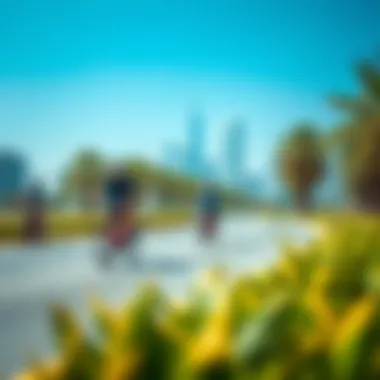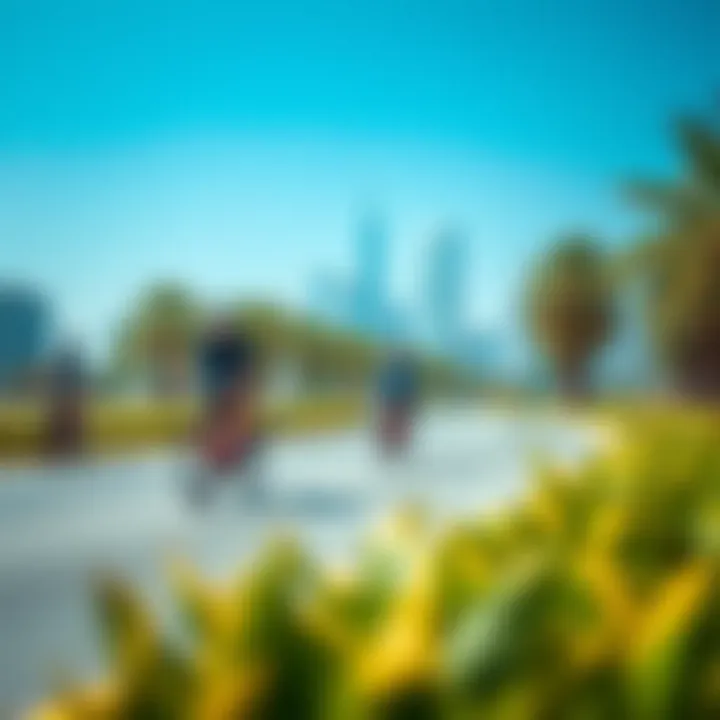Cycling Tracks in Dubai: A Complete Guide


Intro
Cycling has become an integral part of daily life in Dubai, a city that has embraced two wheels as not only a means of transport but also a lifestyle choice. The roads and tracks designed for cycling reflect the city's ambition to promote sustainable urban living. Enthusiasts and casual riders alike find countless opportunities to explore unique cycling routes that weave through the city’s vibrant landscape. This guide aims to uncover the intricacies of these cycling tracks, highlighting their features, the underlying safety considerations, and how they contribute to community health.
With an impressive network of cycling lanes and paths extending throughout various neighborhoods, cycling in Dubai is both accessible and enjoyable. As the population continues to expand, the need for efficient and eco-friendly transportation options has never been more critical. Engaging in cycling not only promotes physical well-being but also fosters a sense of community, allowing residents to interact with their surroundings in a way that supports both social and environmental health.
The following sections will dive deeply into the available cycling routes, essential safety tips, and the impact of these paths on enhancing urban infrastructure. Whether you are a seasoned cyclist or considering taking your first ride, you'll find ample insights to help navigate this buzzing metropolis on two wheels.
Prelude to Cycling in Dubai
As urban landscapes evolve, so does the way residents engage with their surroundings, and cycling in Dubai stands as a vivid testament to this shift. The city has made significant strides in championing cycling as not just a pastime, but a key mode of transport that aligns perfectly with its sustainability goals. In a place known for its spectacular skyline and desert backdrop, the emergence of cycling tracks serves as a vital initiative encouraging residents and tourists alike to embrace a healthier lifestyle.
Cycling in Dubai is far more than just a leisurely activity. It's an active response to global challenges like pollution and traffic congestion. The benefits of incorporating cycling into daily routines are numerous. From improving cardiovascular health to enhancing mental well-being, cycling offers a plethora of advantages for both individuals and the community at large.
Why Cycling Matters in Dubai
In a rapidly developing metropolis, the expansion of cycling tracks is crucial. Dubai faces a unique set of challenges, including heavy traffic and soaring temperatures, which often hinder traditional commuting methods. Here’s where cycling shines:
- Reducing Carbon Footprint: By opting to cycle instead of drive, individuals contribute to lowering greenhouse gas emissions.
- Enhancing Mobility: As the city grows, so do the bottlenecks on the roads. Cycling provides a viable solution for efficient movement across longer distances.
- Fostering Community: Cycling encourages social interaction through group rides and community events, thus knitting a tighter fabric of society.
The local government has recognized these advantages and is keen to foster the growth of cycling. This commitment materializes not only in the development of extensive cycling tracks but also in various community-oriented programs aimed at promoting cycling among all age groups.
"A city that encourages cycling not only promotes a lifestyle choice—it nurtures a thriving community."
Considerations for New Riders
For those interested in exploring the cycling scene in Dubai, being aware of a few factors can enhance the experience:
- Track Conditions: Some paths are adapted for professionals while others cater to casual cyclists. Knowing which track best suits one’s comfort and skill level enhances safety and enjoyment.
- Weather Conditions: The climate can be a barrier. Early morning or late evening rides are often advised to avoid the sweltering midday sun.
- Equipment: Investing in a quality bicycle and gear is vital. Proper bicycles tailored for the terrain can make a considerable difference in the cycling experience.
As we embark on this comprehensive overview of cycling tracks in Dubai, it’s crucial to appreciate not only the investment in infrastructure but also the cultural shift towards this eco-friendly mode of transportation. Whether one is a seasoned cyclist or a newbie, the diverse array of tracks in Dubai promises something for everyone, making city exploration both fun and sustainable.
The Urban Cycling Renaissance
Dubai is currently witnessing a remarkable transformation in urban mobility, often referred to as the Urban Cycling Renaissance. This shift is not merely a change in transportation; it’s a cultural reinvigoration, underscoring the importance of cycling within the fabric of city life. The embrace of cycling in Dubai stands as a vital axis around which sustainable living and community health revolve, making it an essential focal point for current and future urban planning.
Several benefits emerge from this cycling-focused movement. For starters, cycling significantly reduces traffic congestion. With the soaring number of vehicles on the road, transforming more residents into cyclists alleviates the persistent strain on urban infrastructure. Environmental sustainability also benefits immensely; by promoting cycling over motor vehicles, Dubai can cut down on greenhouse gas emissions, thereby enhancing air quality for all.
Moreover, this renaissance fosters a sense of community connection. As neighborhoods become more bike-friendly, residents often find themselves interacting more with their surroundings and each other. Parks and open spaces start to serve dual purposes; they become hubs for cycling and community gatherings. Shared experiences foster a deeper, more engaged citizenry, vital for any growing metropolis.
The introduction of specialized cycling events has also amplified public interest in cycling. Annual events which celebrate cycling, such as the Dubai Ride, showcase the city's commitment to this mode of transport. Events like these encourage first-time cyclists to hop on a bike and join in, thus sparking a larger interest across diverse age groups.
Nevertheless, the renaissance demands foresight in addressing its challenges. Infrastructure must adapt through the development of safe and extensive cycling paths that mesh seamlessly with existing urban elements. Safety measures, such as dedicated lanes and well-placed signage, are not just recommended but necessary. The growing cycling community calls for ongoing discussions about best practices and regulations to ensure all cyclists can enjoy their rides safely.
As urban designers and city planners consider these factors, the challenge rests on their shoulders to implement effective strategies that maintain this momentum. Investors, homebuyers, agents, and developers must therefore pay keen attention to the ongoing trends in cycling infrastructure as they can greatly influence property values and community desirability.
"Cycling isn’t just transport; it embodies a lifestyle choice embraced by those who cherish community, sustainability, and health."
As we venture deeper into the heart of Dubai’s cycling culture, we shall explore specific cycling tracks, their unique offerings, and the infrastructural support crucial to this movement's success.
Key Cycling Tracks in Dubai
The cycling culture in Dubai has blossomed into a vital aspect of the city’s urban landscape. With sprawling tracks that cater to both amateurs and seasoned cyclists, the tracks not only serve recreational purposes but also promote healthier lifestyles and reduce carbon footprints. Residents and visitors alike can enjoy the roads less traveled while taking in Dubai’s unique architectural marvels and natural beauty.
Cycling tracks are more than just routes; they are pathways to community connection, wellness, and environmental consciousness. Understanding the key cycling routes is essential for anyone looking to explore the city on two wheels, highlighting not only where to ride, but also why each track is significant.
Al Qudra Cycle Track
Route Overview
The Al Qudra Cycle Track stands out for its length, totaling about 86 kilometers. This expansive route weaves through the desert, providing a unique blend of scenic isolation and thrilling adventure. The long stretch appeals to cyclists keen to test their endurance, making it a popular choice for both casual riders and competitive athletes. Cyclists find the track is well-marked, which enhances navigation and overall enjoyment.
Furthermore, its secluded environment offers a peaceful escape from the busy city, helping riders connect with nature. Many view this track as a transformative experience; the quiet and open spaces refresh the spirit and provide riders with an opportunity to think freely.
Unique Features
One of the most striking features of the Al Qudra track is the breathtaking sunset view it offers. Cyclists often share stories on forums about how the golden hour transforms the desert landscape into a spellbinding sight.
Another highlight is the availability of refreshment stations along the route, which makes the long ride more manageable. However, it’s vital for cyclists to plan ahead since these stations can sometimes have limited hours, especially during the hotter months.
Accessibility
Al Qudra is accessible via main roads, making it easy for both locals and tourists to reach it. However, there may be a few issues when it comes to public transportation options directly leading to the track. Many cyclists opt to travel by car, as parking facilities are available. While accessibility is commendable, it could improve for those relying on public transport.


Dubai Marina Cycle Path
Scenic Views
Cycling along the Dubai Marina Cycle Path is akin to enjoying a slice of Dubai's modern coastal life. This path offers breathtaking views of the waterfront, not to mention the iconic skyline filled with architectural wonders. Riders can enjoy fresh breezes and the calming sound of waves as they pedal along this route, making it a popular choice for leisurely rides.
Furthermore, the proximity to restaurants and cafes means cyclists can take a delightful pause, soaking up the vibe of Dubai while enjoying refreshments. The path's design encourages joyful interactions among cyclists, further elevating the experience.
Connection to Areas
Connecting various neighborhoods, the Marina Cycle Path serves as a crucial artery within the city’s cycling infrastructure. Direct access to key areas such as Jumeirah Beach and Bluewaters Island allows riders to explore more of Dubai's offerings.
Unfortunately, during peak hours, this pathway can get crowded, which could detract from the overall riding experience. Nevertheless, the path's layout accommodates multiple user types, providing a lane for cyclists and walkers alike, which enhances safety and enjoyment for all.
Safety Measures
Safety is a top priority along the Marina Cycle Path. The separate lanes for cyclists and pedestrians reduce potential conflicts, and signage throughout the path informs and guides users effectively. Well-lit sections at night improve visibility, ensuring cyclists can ride comfortably even after sunset. The local government also conducts regular inspections, addressing any wear and tear promptly.
Jumeirah Corniche
Cultural Significance
Riding along the Jumeirah Corniche is not just a physical activity; it’s an opportunity to engage with the rich cultural tapestry of Dubai. This fully paved track runs parallel to the vibrant beach lifestyle, where families, tourists, and locals mingle. The presence of public art installations, cultural events, and festivals along the route further enriches this experience.
Community Engagement
The Jumeirah Corniche fosters community spirit. Various promotional events encourage group rides, charity events, and family-friendly activities, enhancing interaction among cyclists. Community engagement turns cycling from a solitary hobby into a social platform, making it appealing, especially to newcomers in the city.
Maintenance
Maintaining the Jumeirah Corniche is a collaborative effort between the municipality and community groups. Frequent clean-ups ensure a pleasant environment, giving riders a sense of pride in their local cycling habitat. This maintenance regime encourages responsible usage and maintains the integrity of the space for everyone.
Ras Al Khor Wildlife Sanctuary Track
Biodiversity
This unique cycling track takes riders through the Ras Al Khor Wildlife Sanctuary, which is home to over 450 species of wildlife, including flamingos. The biodiversity here is unmatched, offering cyclists a unique backdrop of nature and wildlife, which is rare in an urban setting. This offers a compelling reason for eco-friendly cycling, enriching both the ride and the overall experience.
Cycling Experience
Cyclists on this track can really appreciate the slower pace that the sanctuary dictates. With designated areas for observation, riders often stop to take pictures and soak in the natural surroundings. This environment promotes a calm atmosphere, diverging from the more frantic settings of city cycling.
Environmental Awareness
Riding through the sanctuary raises awareness about environmental conservation. The track is often used for educational purposes, where various schools and organizations hold cycling events to promote eco-friendly practices. This context solidifies the awareness of environmental importance while providing an enjoyable ride.
Al Mamzar Beach Park Cycle Tracks
Family-Friendly Environment
Al Mamzar Beach Park delivers a family-friendly cycling experience par excellence. The dedicated cycle zone within the park offers safety and comfort for families with children. Parents can cycle alongside their kids, enjoying the scenic views of the beach and park.
Social Activities
Al Mamzar hosts a myriad of social activities ranging from community bike rides to beach events. These activities encourage cyclists to bond with one another while engaging in healthy fun. The vibrant atmosphere turns what could be an individual experience into a shared adventure.
Park Facilities
The facilities at Al Mamzar Beach Park enhance the cycling experience significantly. With playgrounds, picnic areas, and shower facilities, families can easily spend an entire day engaging in various activities. Unlike some other tracks, the amenities here make it easier for families to refresh and regroup during outings.
Infrastructure Supporting Cycling
Creating an environment that supports cycling is crucial for growing this activity in Dubai. Infrastructure isn't merely about having the right paths; it's about building a supportive ecosystem that encourages both casual riders and serious cyclists to take to the roads. Well-designed cycling infrastructure leads to improved safety, enhanced convenience, and positively affects local communities' health and lifestyle choices. This is particularly significant given Dubai's commitment to developing sustainable transport networks.
Bike Sharing Programs
Overview of Programs
Bike sharing programs have gained traction in Dubai as an effective means to promote cycling. These programs provide residents and visitors access to bicycles without the need for ownership. The idea is simple yet impactful: by having bikes readily available, people are more likely to hop on one instead of driving short distances. One key characteristic is their widespread availability across the city, allowing easy access for everyone.
A unique feature of these programs is the integration of technology. Users can use mobile apps to locate, reserve, and unlock bikes. This approach significantly reduces barriers to entry for new cyclists while enhancing the overall experience. However, one must consider the potential drawbacks, such as maintenance issues, which could deter users.
User Accessibility
Accessibility in bike sharing is a game changer. It’s not just about the number of bikes available but ensuring they are in the right places at the right times. Programs typically offer various locations, making it easier for users to find a bike when they need it. This facilitates last-minute decisions to cycle rather than drive.


There’s a solid appeal to having stations strategically placed near major transport hubs, residential areas, and commercial zones. Notably, these sites help in creating cycling-friendly routes throughout the city. However, local infrastructural challenges can sometimes limit expansion, which is a concern that needs addressing as the initiatives gain popularity.
Challenges Faced
While bike sharing may sound like a silver bullet for urban transport, it does come with its challenges. One major issue is vandalism and theft. Programs must constantly invest in securing their bikes to prevent loss. Additionally, congestion on popular cycling routes can cut down on the enjoyment factor, making for a less pleasant experience.
Another consideration involves maintaining an appropriate distribution of bikes. If certain areas have too many bikes and others have none, it could lead to user dissatisfaction. Thus, managing these dynamics effectively is crucial for the success of bike sharing in Dubai.
Cycling Rentals in Dubai
Top Rental Services
Rental services are an essential part of the cycling landscape in Dubai. They offer flexibility for tourists and residents alike, who might not want to buy a bike outright. Companies such as Byky and Rent A Bike have established themselves as solid choices due to their responsive services and diverse fleet of bicycles.
A standout feature is the variety of bicycles available, including mountain bikes and e-bikes. This lets users select a ride that suits their specific needs, whether they seek adventure or a leisurely experience. However, it's crucial to compare the availability of models from each service, as limited options could lead to unmet needs.
Pricing Models
Understanding pricing models is vital for cyclists on a budget. Rental prices vary based on the type of bike and rental duration. Daily rentals are often accessible for short trips, while longer rentals might offer better deals. Some companies even run promotions or subscription models, making frequent cycling more affordable.
A key benefit of having varied pricing strategies includes attracting different user demographics, from tourists to locals. However, potential renters should be aware of hidden fees, which could occur depending on factors like extended rental time or damage coverage.
User Recommendations
User recommendations play a significant role in choosing rental services. Many cyclists rely on reviews to gauge quality and service reliability before making their choice. The local online communities, including forums on Reddit or discussion groups on Facebook, often provide valuable insights.
Cyclists frequently emphasize the importance of customer service alongside the quality of the bikes. A timely and friendly service clarifies the overall experience and can make a world of difference when needing assistance. Engaging positively with the cycling community enhances the local culture and encourages more people to take up cycling as a regular activity.
Safety and Regulations for Cyclists
The importance of safety and regulations in cycling can’t be overstated, especially in a vibrant metropolis like Dubai. Ensuring that cyclists are aware of the laws and best practices contributes greatly to the overall cycling experience. Having a solid foundation in safety not only protects riders but also enhances the community’s confidence in cycling as a viable mode of transportation. Moreover, regulations help in promoting responsible behavior on the roads, fostering a culture of respect between cyclists, motorists, and pedestrians. Through these provisions, we can cultivate a safer and more welcoming environment for everyone.
Traffic Laws and Cycling
Legal Responsibilities
In Dubai, understanding legal responsibilities is essential for every cyclist. This framework aims to ensure that cyclists are aware of their obligations on the road, which includes following traffic signals, not cycling on sidewalks where it is prohibited, and yielding to pedestrians. By adhering to these laws, cyclists not only protect themselves but also share the road safely with others. A key aspect of these responsibilities is ensuring cyclists wear helmets, as this has been shown to significantly lower the risk of head injuries. In essence, reinforcing safe cycling habits through these legal parameters encourages a collaborative urban transportation network.
Penalties
When it comes to penalties, the Dubai authorities have implemented a range of fines for cyclists who violate traffic laws. This serves as both a deterrent and a method for regulating safer behavior. For example, riding against traffic can lead to substantial fines, highlighting the danger this poses not only to the cyclist but also to other road users. While some may view these penalties as harsh, they play a critical role in enforcing safe practices that ultimately benefit all members of the community.
Awareness Campaigns
Increasing public knowledge through awareness campaigns is a pivotal strategy in promoting cycling safety. These campaigns often focus on educating both cyclists and motorists about road-sharing and the rights of cyclists. Promoting initiatives like 'Share the Road,' is particularly effective. Additionally, these campaigns usually use local media, social platforms, and community events to reach a wider audience. The unique feature of these campaigns is their dual focus—they not only aim to inform cyclists about their responsibilities but also to engage motorists, reducing conflicts. The advantage of such efforts is the creation of an informed public that respects and understands the dynamics of cycling in an urban setting.
Safety Gear Essentials
Safety gear plays a fundamental role in protecting cyclists while navigating urban routes. Explaining the essentials can significantly reduce the risks associated with cycling.
Recommended Equipment
When talking about recommended equipment, certain gear stands out for its necessity. A properly fitted helmet, reflective clothing, and lights are essential while cycling, especially during low-light conditions. These items are not merely suggestions; they are vital tools for safety. Additionally, having a repair kit on hand ensures that minor issues can be fixed on the go, which helps maintain the cyclist’s confidence and independence. The value of investing in quality gear cannot be understated, as it does not only enhance personal security but also encourages newcomers to engage with the cycling community.
Accident Prevention
In terms of accident prevention, knowledge is the first line of defense. Understanding how to anticipate and react to the behaviors of motor vehicles can significantly reduce the likelihood of accidents. Cyclists should be trained to observe traffic patterns, maintain proper signaling when turning, and anticipate problems when sharing the road. The comprehensive approach this aspect of safety takes addresses both bike handling skills and situational awareness, turning cycling into a more predictable and less risky activity over time. Still, its nuances can deter some from cycling, emphasizing the need for ongoing education.
Local Resources
Locating local resources can be indispensable for cyclists looking to stay safe and informed. Various organizations offer valuable information, workshops, and safety training specifically designed for cyclists. The Dubai Sports Council, for example, frequently organizes events to teach safe cycling practices. A unique advantage these organizations provide is the support network they create, linking cyclists with experienced mentors or fellow enthusiasts. While these resources can foster community, the challenge remains in raising awareness to attract more participants and ensure the resources are utilized effectively.
By understanding these safety regulations and gear essentials, cyclists can better navigate the scenic routes of Dubai while prioritizing their safety and that of others.
The Health Benefits of Cycling
Cycling offers a myriad of health benefits that contribute positively to both physical and mental wellness. As the popularity of cycling continues to soar in Dubai, it’s important to understand how involving yourself in this activity can be a stepping stone toward a healthier lifestyle. From cardiovascular enhancements to mental well-being, these advantages form a compelling case for why cycling should be a part of daily routines.
Physical Health Enhancements
Cardiovascular Benefits
Engaging in cycling regularly has profound effects on cardiovascular health. Pedaling engages the heart muscle, strengthening it over time, which leads to improved blood circulation. A notable aspect of cardiovascular benefits is the reduced risk of heart disease. According to studies, individuals who cycle consistently tend to have lower blood pressure and cholesterol levels, essential factors in cardiovascular fitness. The unique aspect of cycling is that it offers a low-impact workout, making it suitable for people of various age groups and fitness levels. This flexibility makes it a popular choice for many, providing health benefits while also being enjoyable.
Muscle Development


The act of cycling naturally engages various muscle groups, particularly in the lower body. Regular cycling contributes to muscle strength and endurance, making this activity beneficial for both experienced athletes and beginners alike. The quads, hamstrings, calves, and glutes are worked extensively, enhancing overall muscle tone. Moreover, as cyclists increase their intensity or distance, they can also improve their muscle resilience. One distinctive feature is that cycling can be adjusted easily, whether it's a leisurely ride in Jumeirah Park or a challenging trek along Al Qudra. This versatility allows individuals to tailor their experience according to their fitness goals.
Weight Management
Cycling plays a crucial role in weight management as it burns calories effectively, making it a fantastic addition to weight loss strategies. A brisk ride can burn a significant amount of calories depending on the duration and intensity of the exercise. The key characteristic that makes cycling a popular choice in weight management is its adaptability; it can be turned into a high-intensity workout or a relaxed ride depending on one's preferences. A unique benefit is the ability to incorporate cycling into daily commutes, adding physical activity to one's routine without dedicating extra time solely for exercise. However, one must keep in mind that proper nutrition also plays a vital role in weight management alongside regular cycling.
Mental Well-Being Through Cycling
Stress Reduction
Cycling is widely recognized for its ability to reduce stress levels. When riding, individuals experience a release of endorphins, the body's natural mood elevators. This specific aspect makes cycling a valuable tool for coping with daily stresses. Riders often find that they can clear their minds and reflect while on a bike, enhancing mental clarity. A distinct feature of this benefit is its social aspect; group rides can foster a sense of community and connection that further alleviates feelings of loneliness or anxiety. The appeal lies in the ability to combine physical activity with social interaction, creating a holistic approach to stress relief.
Community Interaction
Participating in cycling groups or clubs fosters a sense of community that can greatly enhance mental well-being. Engaging with fellow cyclists creates opportunities for social interaction that can lead to lasting friendships and support networks. This unique feature is not only beneficial for building connections but also encourages newcomers to cycling to get involved, making the sport more accessible. The camaraderie in community rides in areas like Dubai Marina contributes to a positive environment where individuals feel supported in their fitness journeys.
Cognitive Functions
Cycling not only benefits the body but also promotes cognitive health. Research shows that regular physical activity improves focus, memory, and overall brain function. One important aspect is that exposure to nature while cycling—such as the serene pathways of Al Mamzar Beach Park—can aid in reducing mental fatigue. This aspect is often overlooked; cycling offers a dual benefit of physical exercise and mental stimulation through the enrichment of natural environments. As a bonus, this engagement can enhance creativity and problem-solving skills, making cycling more than just a physical activity.
Future of Cycling Tracks in Dubai
The landscape of cycling in Dubai is changing rapidly. This city is no longer just known for its towering skyscrapers and shopping malls; it’s becoming a hub for cycling enthusiasts. The development of cycling tracks is essential not only for promoting a greener mode of transport but also for enhancing the urban lifestyle. As more people become health-conscious and eco-aware, the importance of cycling tracks in Dubai cannot be overstated. Many elements contribute to their future development including government support, community involvement, and newer technologies that make biking safer and more appealing.
Urban Development Plans
Government Initiatives
In the heart of Dubai’s cycling expansion are numerous government initiatives that aim to integrate cycling into the urban fabric. These plans often highlight a commitment to sustainability and public health. The Dubai Urban Plan 2040 envisions a city where cycling is part of daily life, encouraging officials to allocate resources to develop safe cycling tracks throughout various neighborhoods. This approach is not just a beneficial choice; it's a proactive initiative aimed at reducing traffic congestion and air pollution.
A standout feature of these government efforts is the collaboration with international urban planners who have experience in promoting cycling-friendly cities. One of the inherent advantages of this is that it combines local knowledge with international best practices, fostering a more holistic urban cycling strategy.
Community Involvement
Community involvement plays a pivotal role in shaping the future of cycling tracks. Local residents and cycling groups are essential to creating awareness and garnering support for new cycling initiatives. There’s something powerful about a community rallying together for a cause. It brings not just attention but also funding toward the development of these tracks.
Highlights of community involvement often include organized cycling events and feedback sessions where residents can voice their ideas. Unique features such as these events help cultivate a sense of ownership in the community and encourage diverse participation. It’s a symbiotic relationship where community needs directly influence urban development.
Sustainability Efforts
Sustainability efforts are deeply intertwined with the vision for future cycling tracks. It’s not just about creating pathways; it’s about making them environmentally friendly. Projects often emphasize the use of recycled materials, energy-efficient lighting, and native landscaping that requires less water. The emphasis here is on building cycling tracks that contribute positively to local ecosystems rather than disrupting them.
Additionally, initiatives geared towards sustainability attract wider funding opportunities, as they align with global movements toward reducing carbon footprints and enhancing environmental health. They ensure that even as development occurs, it is not at the expense of nature, promoting a balanced coexistence.
Innovative Cycling Technologies
Smart Biking Solutions
Technological innovation is making its mark in the world of cycling, especially through smart biking solutions. These advancements can provide real-time information on bike availability, weather conditions, and track maintenance. Such data is pivotal for enhancing the user experience and elevates the status of cycling as a go-to transport option.
One of the unique features of these solutions is their integration with public transport systems, offering users maximum convenience. The blend of cycling with broader transportation networks is a strategic effort to position cycling as a sustainable alternative that’s not just about the individual experience but about the community as a whole.
AI in Bike Maintenance
The integration of AI in bike maintenance is yet another exciting development. It ensures that bicycles are kept in optimum condition, minimizing breakdowns. AI can analyze data from devices embedded in bikes to predict when a bike needs servicing, thereby enhancing safety and reliability for users.
What makes this particularly advantageous is the reduction in repair costs and improved customer satisfaction. Hence, cyclists can enjoy a seamless riding experience, encouraging them to utilize these facilities regularly, contributing to the cycling culture.
Future Trends in Urban Transport
Future trends in urban transport indicate a significant shift towards sustainability, and cycling will be at the forefront. More locales are expected to prioritize lane allocations exclusively for cyclists, possibly even implementing smart traffic systems that favor bikes over cars at intersections. This is likely to usher in a new era of commuting where cycling is a favored option.
Unique features such as integrated cycling apps can keep track of rides and promote local events, connecting cyclists further in the city. It will create a collective consciousness among users, fostering a vibrant cycling community that enhances life on wheels.
The path forward for cycling in Dubai is paved with promise, interlinking community efforts with government initiatives and technological advancements, driving a collective movement toward a cycling revolution.
Epilogue
In summarizing the comprehensive exploration of cycling tracks in Dubai, it's crucial to underscore the multifaceted benefits these routes offer to both individuals and the broader community. Cycling in Dubai isn’t merely about leisure; it serves as a vital component of urban living and sustainable transport. As the city increasingly embraces the cycling culture, it fosters health, connectivity, and environmental consciousness among its residents.
The importance of cycling tracks can be dissected into several key elements:
- Health and Fitness: Regular cycling enhances cardiovascular health, promotes muscle development, and aids in effective weight management. The very act of pedaling along scenic routes aids physical well-being, encouraging individuals to integrate exercise into their daily routines.
- Environmental Impact: With an ardent push for sustainability, cycling emerges as an eco-friendly mode of transportation. By reducing dependency on cars, cyclists contribute to lower emissions, thereby playing a role in combating urban pollution.
- Community Engagement: The cycling culture facilitates social interactions. Whether it’s local riding groups or events organized around cycling, these tracks become spaces for community bonding, promoting a sense of belonging among individuals from diverse backgrounds.
- Urban Infrastructure Development: As Dubai invests heavily in cycling infrastructure, the socio-economic implications become clear. Enhanced cycling tracks boost real estate values in adjacent areas, attracting investments and improving the quality of life for residents.
Going forward, the continuous development of cycling tracks will solidify Dubai’s commitment to a healthier lifestyle. Local policymakers and urban planners are challenged to innovate and adapt, addressing existing barriers while enhancing the overall cycling experience. If we consider the ongoing urban expansion and technological advances in bike-sharing and rentals, the future looks promising for cyclists in Dubai.
In a nutshell, the evolution of cycling tracks transcends mere transportation; it serves as a beacon of progress in health, environment, and community engagement. Embracing cycling not only creates healthier individuals but fosters a responsible and vibrant urban living landscape.
"The journey of a thousand miles begins with a single pedal stroke."
For further information on cycling safety and regulations, check out resources at gov.ae and worldhealthorganization.org. The transformation Dubai is experiencing could well be a model for other cities worldwide, demonstrating the power of cycling as a catalyst for urban renewal.



